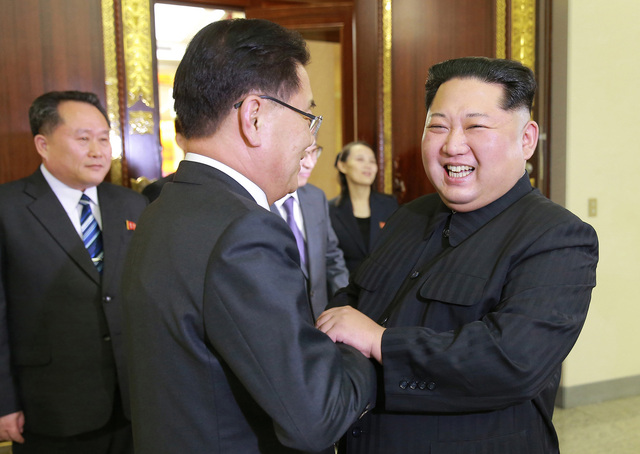 |
|
North Korean leader Kim Jong-un meets with South Korean special envoy Chung Eui-yong in Pyongyang on Mar. 5. In the background are Kim Yo-jong, first vice director of the Korean Workers’ Party Central Committee and Ri Son-gwon, chairman of the Committee for the Peaceful Reunification of the Fatherland.
|
A variety of factors have led to the change in attitude on the part of the North Korean leader
North Korean leader Kim Jong-un’s proposal to meet “as soon as possible” with US President Donald Trump and message about potentially “producing major results if we speak directly” are being read as signals of his active commitment to achieving a breakthrough in the current situation. It’s a move with multiple purposes: helping to turn the situation around with expectation-defying actions, while simultaneously achieving improvements in relations with the US, stabilizing the Korean Peninsula situation, breaking the North out of its international isolation, and overcoming economic sanctions. Kim’s attitude stands in sharp contrast with his disregard for South Korean President Moon Jae-in’s dialogue proposals throughout 2017. The change is being attributed to the greater urgency of a breakthrough as intensifying international sanctions have resulted in deepening international isolation and economic difficulties, along with Moon’s efforts to use the timely arrival of the Pyeongchang Winter Olympics as an opportunity to turn the situation around. Analysts also suggested North Korea’s own military confidence may have played a part, with its declaration of “the completion of the state nuclear force” in late November of last year. Following its sixth nuclear test in September and its November test launch of the Hwasong-15 ICBM, Pyongyang proclaimed itself to have established a “nuclear deterrent.” The issue of dialogue with Washington did not receive major emphasis from Kim in his New Year’s address on Jan. 1. While he made gestures of reconciliation to the South with North Korea’s participation in the Olympics, the sending of delegations, and a proposal for inter-Korean dialogue, his attitude toward the US was one of overt threats and antagonism – as with remarks stating that the “entire continental United States is within range of our nuclear strike, and the nuclear button is always on the desk in my office.” At that point, Pyongyang’s approach was one of separate responses to Seoul and Washington. The Moon administration’s active efforts at persuasion and mediation are seen as playing a part in Kim’s sudden shift toward pursuing dialogue with the US. During a meeting with North Korean Workers’ Party first vice director Kim Yo-jong on Mar. 10, Moon said it was “essential to have dialogue between North Korea and the US as soon as possible, if only for the advancement of inter-Korean relations.” Moon also explained about the need for North Korea-US dialogue in a meeting with US Vice President Mike Pence. On his way back to the US on Feb. 12, Pence started the conversation by declaring, “If you [North Korea] want to talk, we’ll talk.” Moon’s efforts at mediating dialogue between Pyongyang and Washington gained further traction in a Feb. 25 meeting with Workers’ Party vice chairman Kim Yong-chol, who declared that North Korea was “quite willing” to have dialogue with the US. “Kim Jong-un may have been the one who set the change in situation in motion, but he’s been aligning with the South Korean government in terms of the subsequent schedule and agenda,” said University of North Korean Studies professor Yang Moo-jin. Kim Jong-un working toward a comprehensive deal with the US At the same time, Kim has adopted an unconventional approach with his speed and “high altitude” tactics in making a surprise summit proposal in the absence of almost any working-level coordination in dialogue with the South or the US. His tactics are seen as suggesting his aim to have the top decision-makers take action to resolve areas of mutual interest all at once within a broader framework, including the nuclear and sanctions issues and forming diplomatic relations with the US. “He seems to want to go straight to a comprehensive deal without going through exploratory or preliminary dialogue stages,” a Blue House senior official said. Institute for National Security Strategy senior research fellow Cho Sung-ryul said that North Korea “seems to think it can hold full-scale negotiations on equal footing with the US now that it has declared its ‘complete nuclear armament.’” Dongguk University professor Kim Yong-hyun said Pyongyang’s aim is to “open up the space itself as much as possible to resolve the nuclear issue, the issue of its regime’s security, and diplomatic relations with the US through generous negotiations.” Another factor may be the past failures of working-level agreements with the 1994 Agreed Framework in Geneva and the September 19 Joint Statement from the Six-Party Talks in 2005. Pyongyang may have sense a need to ensure the highest level and binding force in any agreements. The fact that past inter-Korean summits took place at the end of the South Korean President’s term – and that agreement terms often went unfulfilled once a new administration came into office – may have also served as a lesson. North Korea’s conclusion may have been that it should maximize the effects of improvements in relations by having both the inter-Korean and North Korea-US summits take place as soon as possible. By Park Byong-su, senior staff writer and Noh Ji-won, staff reporter Please direct questions or comments to [english@hani.co.kr]






